Page 243 of 407
3. Using a flat blade screwdriver, carefully remove the
shift lock manual override cover which is located on the
PRNDL bezel.
4. Press and maintain firm pressure on the brake pedal.
5. Using the screwdriver, reach into the manual override
opening. Press and hold the shift lock lever down.6. Move the shift lever into the NEUTRAL position.
7. The vehicle may then be started in NEUTRAL.
Have your vehicle inspected by your local authorized
dealer, if the shift lock manual override has been used.
Five–Speed Automatic Transmission
The electronically controlled transmission provides a
precise shift schedule. The transmission electronics are
self-calibrating; therefore, the first few shifts on a new
vehicle, may be somewhat abrupt. This is a normal
condition, and precision shifts will develop within a few
hundred miles/kilometers.
Interlock Manual Override
242 STARTING AND OPERATING
Page 244 of 407
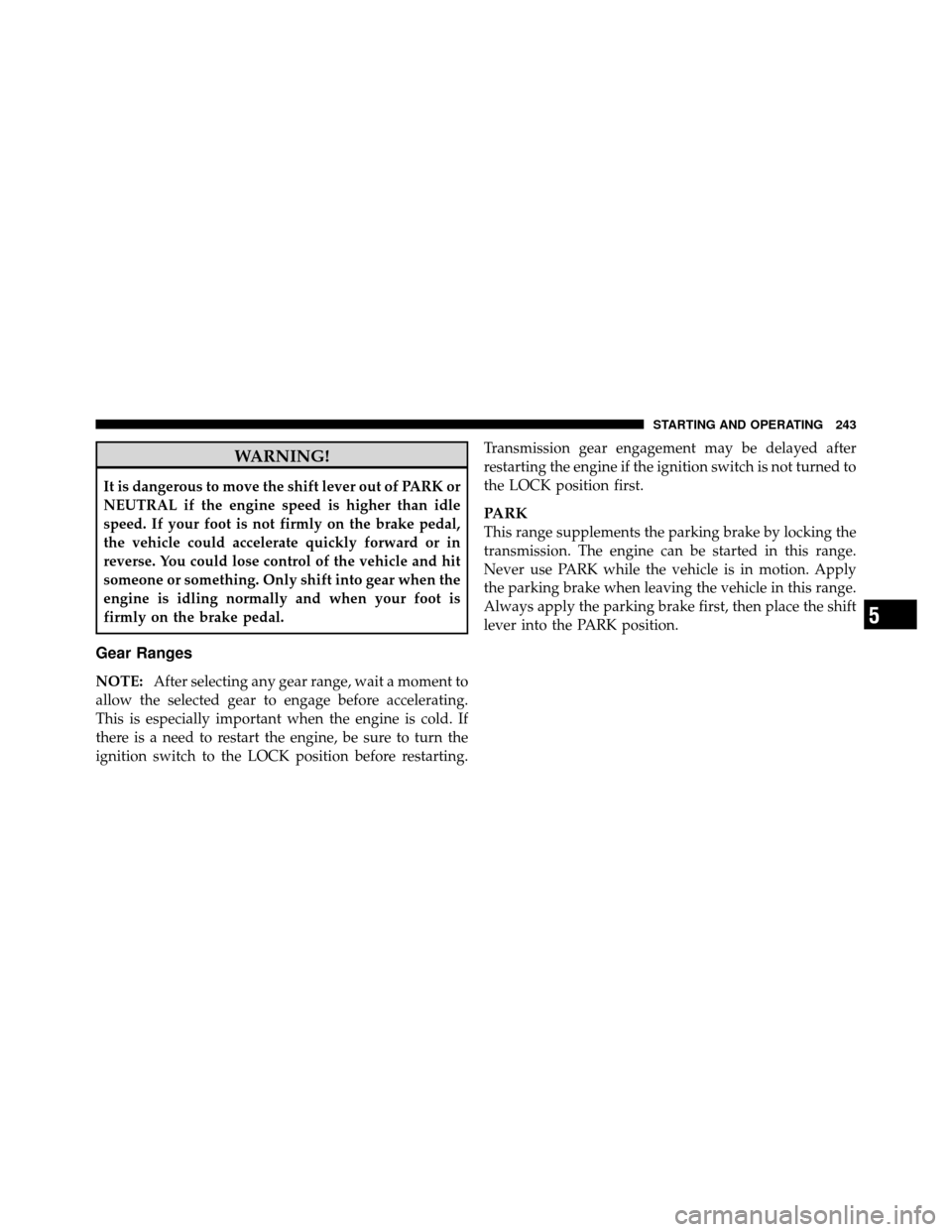
WARNING!
It is dangerous to move the shift lever out of PARK or
NEUTRAL if the engine speed is higher than idle
speed. If your foot is not firmly on the brake pedal,
the vehicle could accelerate quickly forward or in
reverse. You could lose control of the vehicle and hit
someone or something. Only shift into gear when the
engine is idling normally and when your foot is
firmly on the brake pedal.
Gear Ranges
NOTE:After selecting any gear range, wait a moment to
allow the selected gear to engage before accelerating.
This is especially important when the engine is cold. If
there is a need to restart the engine, be sure to turn the
ignition switch to the LOCK position before restarting. Transmission gear engagement may be delayed after
restarting the engine if the ignition switch is not turned to
the LOCK position first.
PARK
This range supplements the parking brake by locking the
transmission. The engine can be started in this range.
Never use PARK while the vehicle is in motion. Apply
the parking brake when leaving the vehicle in this range.
Always apply the parking brake first, then place the shift
lever into the PARK position.
5
STARTING AND OPERATING 243
Page 245 of 407
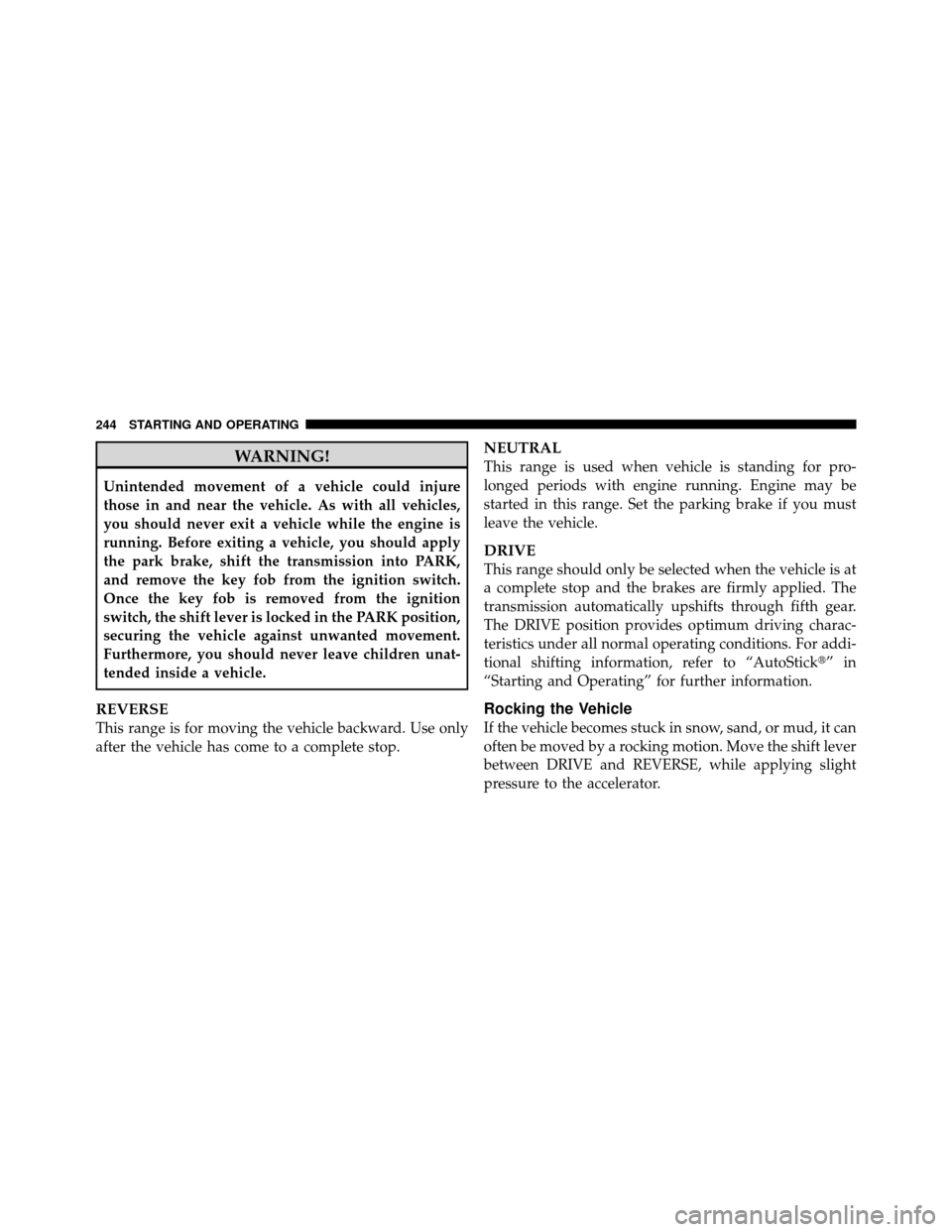
WARNING!
Unintended movement of a vehicle could injure
those in and near the vehicle. As with all vehicles,
you should never exit a vehicle while the engine is
running. Before exiting a vehicle, you should apply
the park brake, shift the transmission into PARK,
and remove the key fob from the ignition switch.
Once the key fob is removed from the ignition
switch, the shift lever is locked in the PARK position,
securing the vehicle against unwanted movement.
Furthermore, you should never leave children unat-
tended inside a vehicle.
REVERSE
This range is for moving the vehicle backward. Use only
after the vehicle has come to a complete stop.
NEUTRAL
This range is used when vehicle is standing for pro-
longed periods with engine running. Engine may be
started in this range. Set the parking brake if you must
leave the vehicle.
DRIVE
This range should only be selected when the vehicle is at
a complete stop and the brakes are firmly applied. The
transmission automatically upshifts through fifth gear.
The DRIVE position provides optimum driving charac-
teristics under all normal operating conditions. For addi-
tional shifting information, refer to “AutoStick�”in
“Starting and Operating” for further information.
Rocking the Vehicle
If the vehicle becomes stuck in snow, sand, or mud, it can
often be moved by a rocking motion. Move the shift lever
between DRIVE and REVERSE, while applying slight
pressure to the accelerator.
244 STARTING AND OPERATING
Page 246 of 407
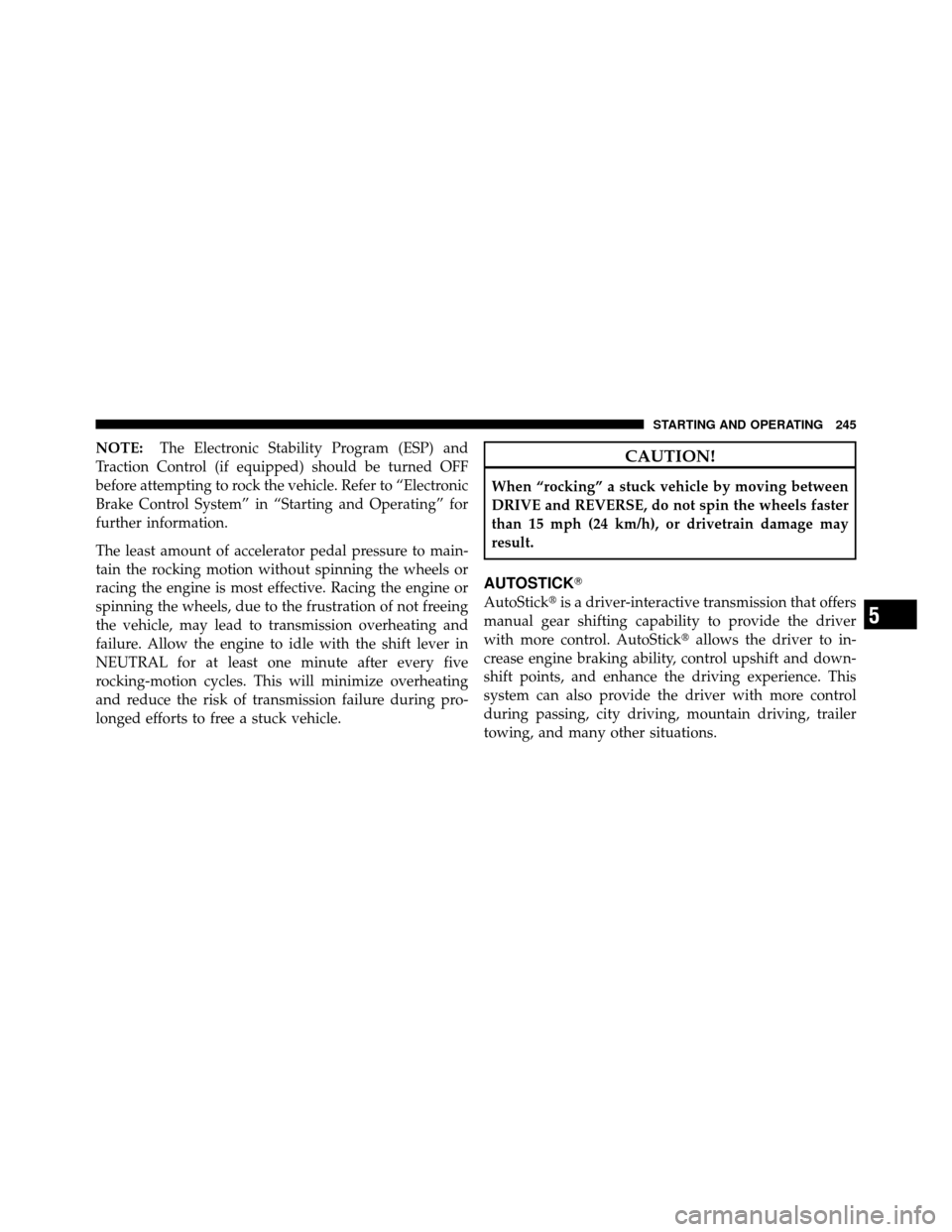
NOTE:The Electronic Stability Program (ESP) and
Traction Control (if equipped) should be turned OFF
before attempting to rock the vehicle. Refer to “Electronic
Brake Control System” in “Starting and Operating” for
further information.
The least amount of accelerator pedal pressure to main-
tain the rocking motion without spinning the wheels or
racing the engine is most effective. Racing the engine or
spinning the wheels, due to the frustration of not freeing
the vehicle, may lead to transmission overheating and
failure. Allow the engine to idle with the shift lever in
NEUTRAL for at least one minute after every five
rocking-motion cycles. This will minimize overheating
and reduce the risk of transmission failure during pro-
longed efforts to free a stuck vehicle.CAUTION!
When “rocking” a stuck vehicle by moving between
DRIVE and REVERSE, do not spin the wheels faster
than 15 mph (24 km/h), or drivetrain damage may
result.
AUTOSTICK�
AutoStick� is a driver-interactive transmission that offers
manual gear shifting capability to provide the driver
with more control. AutoStick� allows the driver to in-
crease engine braking ability, control upshift and down-
shift points, and enhance the driving experience. This
system can also provide the driver with more control
during passing, city driving, mountain driving, trailer
towing, and many other situations.
5
STARTING AND OPERATING 245
Page 247 of 407
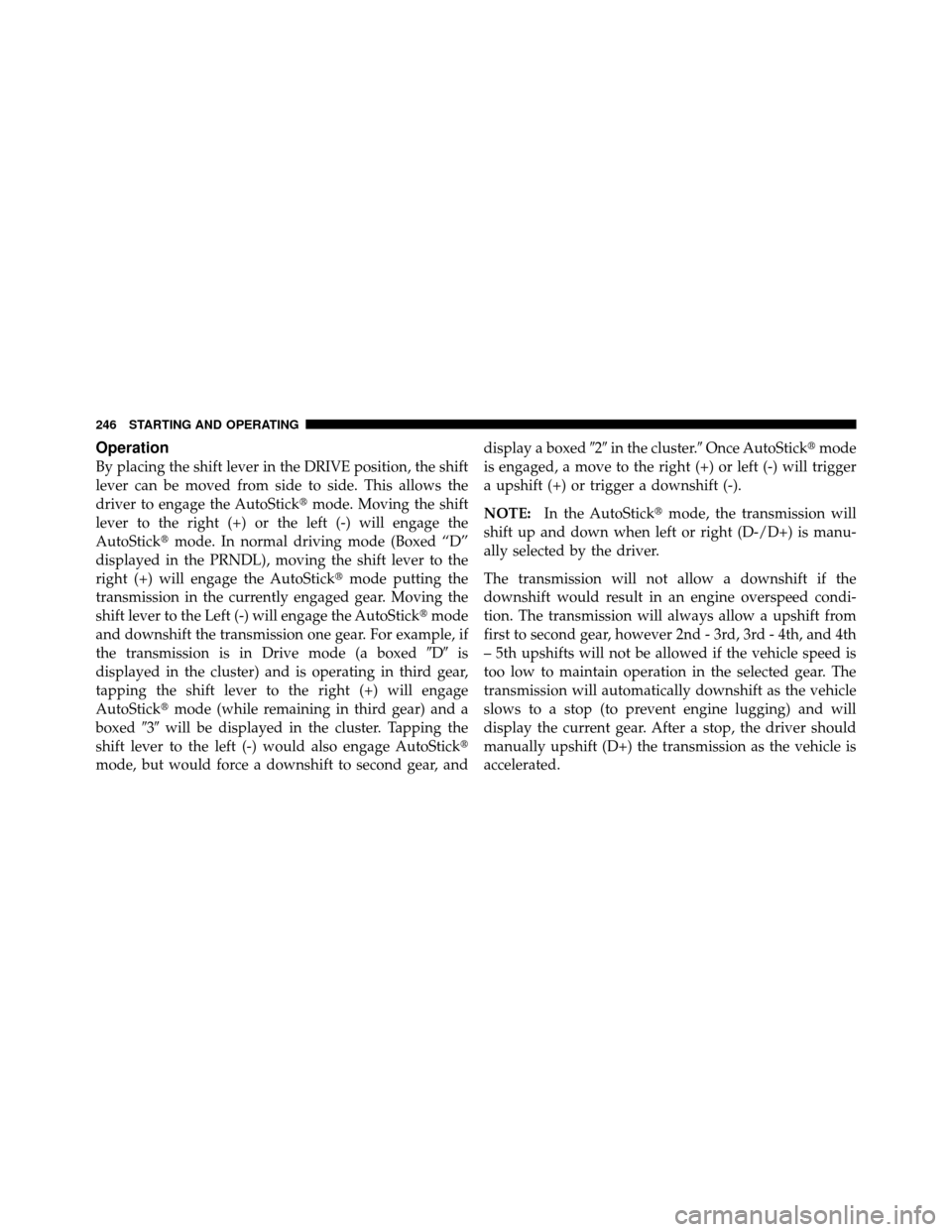
Operation
By placing the shift lever in the DRIVE position, the shift
lever can be moved from side to side. This allows the
driver to engage the AutoStick�mode. Moving the shift
lever to the right (+) or the left (-) will engage the
AutoStick� mode. In normal driving mode (Boxed “D”
displayed in the PRNDL), moving the shift lever to the
right (+) will engage the AutoStick� mode putting the
transmission in the currently engaged gear. Moving the
shift lever to the Left (-) will engage the AutoStick� mode
and downshift the transmission one gear. For example, if
the transmission is in Drive mode (a boxed �D�is
displayed in the cluster) and is operating in third gear,
tapping the shift lever to the right (+) will engage
AutoStick� mode (while remaining in third gear) and a
boxed �3�will be displayed in the cluster. Tapping the
shift lever to the left (-) would also engage AutoStick �
mode, but would force a downshift to second gear, and display a boxed
�2�in the cluster.� Once AutoStick� mode
is engaged, a move to the right (+) or left (-) will trigger
a upshift (+) or trigger a downshift (-).
NOTE: In the AutoStick� mode, the transmission will
shift up and down when left or right (D-/D+) is manu-
ally selected by the driver.
The transmission will not allow a downshift if the
downshift would result in an engine overspeed condi-
tion. The transmission will always allow a upshift from
first to second gear, however 2nd - 3rd, 3rd - 4th, and 4th
– 5th upshifts will not be allowed if the vehicle speed is
too low to maintain operation in the selected gear. The
transmission will automatically downshift as the vehicle
slows to a stop (to prevent engine lugging) and will
display the current gear. After a stop, the driver should
manually upshift (D+) the transmission as the vehicle is
accelerated.
246 STARTING AND OPERATING
Page 248 of 407
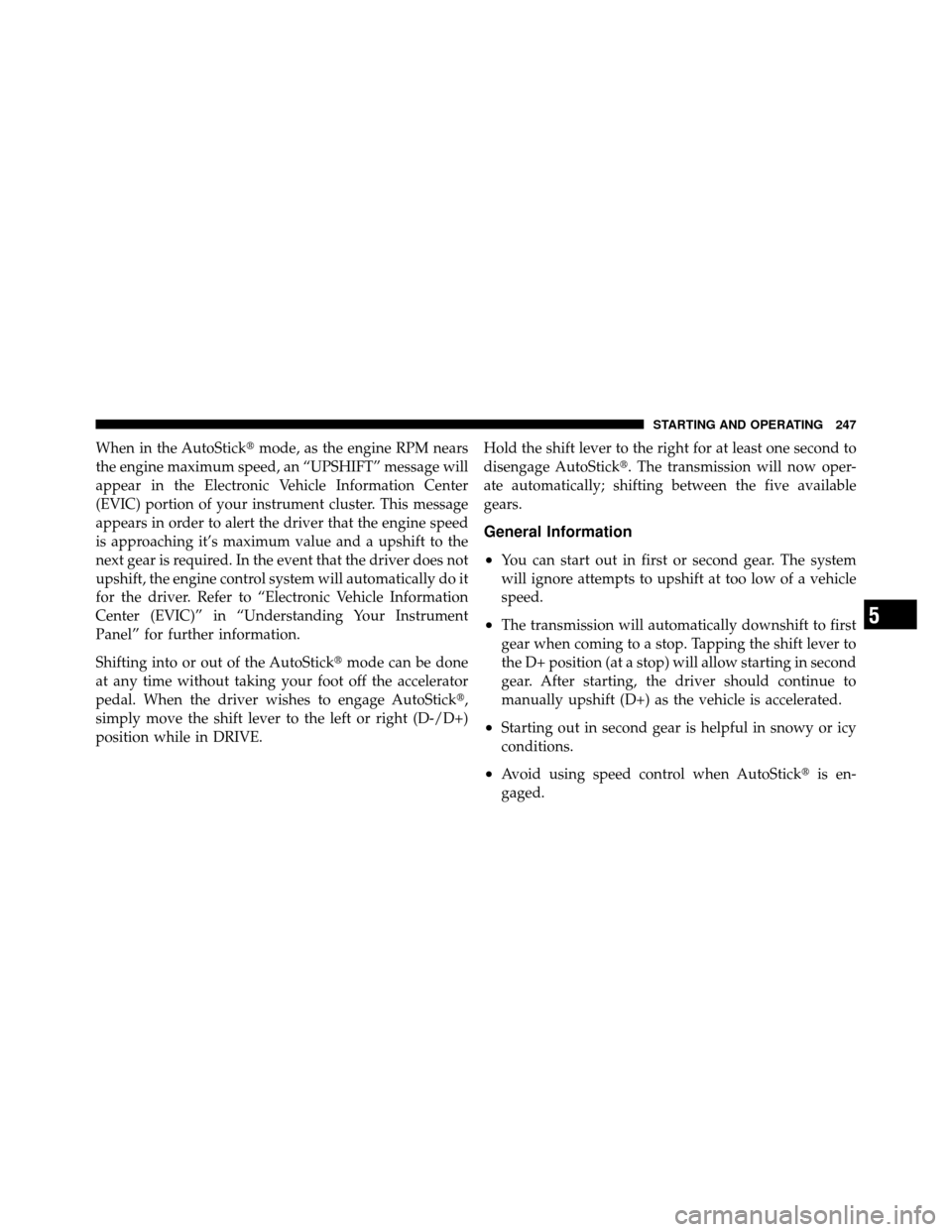
When in the AutoStick�mode, as the engine RPM nears
the engine maximum speed, an “UPSHIFT” message will
appear in the Electronic Vehicle Information Center
(EVIC) portion of your instrument cluster. This message
appears in order to alert the driver that the engine speed
is approaching it’s maximum value and a upshift to the
next gear is required. In the event that the driver does not
upshift, the engine control system will automatically do it
for the driver. Refer to “Electronic Vehicle Information
Center (EVIC)” in “Understanding Your Instrument
Panel” for further information.
Shifting into or out of the AutoStick� mode can be done
at any time without taking your foot off the accelerator
pedal. When the driver wishes to engage AutoStick �,
simply move the shift lever to the left or right (D-/D+)
position while in DRIVE. Hold the shift lever to the right for at least one second to
disengage AutoStick�. The transmission will now oper-
ate automatically; shifting between the five available
gears.
General Information
•
You can start out in first or second gear. The system
will ignore attempts to upshift at too low of a vehicle
speed.
•The transmission will automatically downshift to first
gear when coming to a stop. Tapping the shift lever to
the D+ position (at a stop) will allow starting in second
gear. After starting, the driver should continue to
manually upshift (D+) as the vehicle is accelerated.
•Starting out in second gear is helpful in snowy or icy
conditions.
•Avoid using speed control when AutoStick�
is en-
gaged.
5
STARTING AND OPERATING 247
Page 249 of 407

•The transmission will automatically shift up when
maximum engine speed is reached while AutoStick�is
engaged.
•Transmission shifting will be more noticeable when
AutoStick� is engaged.
POWER STEERING
The standard power steering system will give you good
vehicle response and increased ease of maneuverability
in tight spaces. The system will provide mechanical
steering capability if power assist is lost.
If for some reason the power assist is interrupted, it will
still be possible to steer your vehicle. Under these condi-
tions, you will observe a substantial increase in steering
effort, especially at very low vehicle speeds and during
parking maneuvers. NOTE:
•Increased noise levels at the end of the steering wheel
travel are considered normal and do not indicate that
there is a problem with the power steering system.
•Upon initial start-up in cold weather, the power steer-
ing pump may make noise for a short amount of time.
This is due to the cold, thick fluid in the steering
system. This noise should be considered normal, and it
does not in any way damage the steering system.
WARNING!
Continued operation with reduced power steering
assist could pose a safety risk to yourself and others.
Service should be obtained as soon as possible.
248 STARTING AND OPERATING
Page 250 of 407

CAUTION!
Prolonged operation of the steering system at the end
of the steering wheel travel will increase the steering
fluid temperature and it should be avoided when
possible. Damage to the power steering pump may
occur.
Power Steering Fluid Check
The power steering system requires the use of MOPAR�
Hydraulic System Power Steering Fluid or equivalent,
which meets Chrysler Material Standard MS-10838.
CAUTION!
Do not use chemical flushes in your power steering
system as the chemicals can damage your power
steering components. Such damage is not covered by
the New Vehicle Limited Warranty.
WARNING!
Do not use Automatic Transmission Fluid (ATF), or
other types of power steering fluids, when servicing
the power steering system of this vehicle. Damage to
the power steering system can result from the use of
the wrong power steering fluid.
Checking the power steering fluid level at a defined
service interval is not required. The fluid should only be
checked if a leak is suspected, abnormal noises are
apparent, and/or the system is not functioning as antici-
pated. Coordinate inspection efforts through an autho-
rized dealer.
5
STARTING AND OPERATING 249